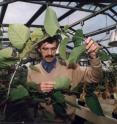Leicester research paves way for first use in Europe of an insect to fight invasive plant
Researchers at the University of Leicester have paved the way for the first ever use in Europe of an insect (biocontrol) to combat an invasive plant species in Britain. University of Leicester biologists established that the Japanese Knotweed in Britain was one the biggest females in the world- a clone of cuttings brought into Britain in the 1850s. Costs of controlling it in Britain have been put at £1.5 billion.
Defra's Food and Environment Research Agency (Fera) has now launched a public consultation exercise into plans to control the Japanese Knotweed using a highly specialist sap-sucking insect –or psyllid- called Aphalara itadori.
This follows a rigorous testing regime undertaken by the not-for-profit research organisation CABI at their quarantine laboratories, the purpose of which is to be as sure as possible that potential biocontrol organisms are restricted to Japanese Knotweed and cannot be tempted to stray onto related British plants or economically important species.
Lead scientist Dick Shaw said: "Using information compiled by scientists at the University of Leicester, Biocontrol experts at CABI were able to focus their collecting efforts on the precise region of Japan where the European clone of Japanese Knotweed originated.
"A number of Japanese invertebrates and micro organisms have been subjected to a rigorous testing regime. The aim of biological control is not to eradicate the target organism, but to weaken it so as to restrict spread and increase the effectiveness of other control measures (i.e less herbicide use)."
The psyllid doesn't actually eat the plant, but sucks the sap like an aphid, and also produces vast numbers of offspring on Japanese Knotweed plants, which severely affect the morphology and vigour of the plant.
Dr Shaw added: "Since there has never been a release of a biocontrol agent for a plant species in Europe, extreme caution is being exercised by all concerned". The proposed organism has now satisfied the scientific community that the proposed release under licence would be both safe and beneficial to the environment. On July 23 2009 the government inaugurated a public consultation on the release, subject to the satisfactory conclusion of this process, approval should be granted for the first releases in April 2010.
"Early releases would be made only under licence, and would be closely monitored, with appropriate contingency plans in place. At the point that the organism is declared to be ordinarily resident, anybody may move it between knotweed sites. Given the fact that our Japanese knotweed is a single clone I feel we have excellent prospects for the specific and effective control of Japanese Knotweed in Britain. "
University of Leicester's role in breakthrough advance in fight against Japanese Knotweed
Work on Japanese Knotweed at the University of Leicester by Dr John Bailey, of the Department of Biology, started in the 1980s and after the award of a PhD on the subject in 1989, the research continued with the able assistance of PhD students Michelle Hollingsworth and Catherine Pashley.
The original work of Dr Bailey established that all the Japanese Knotweed in Britain was octoploid (88 chromosomes) and that only female plants occurred. Extensive hybridisation was observed to be taking place between Japanese Knotweed and both Giant Knotweed and Russian Vine. The hybrid between Japanese Knotweed and Giant Knotweed (Bohemian Knotweed) is now known to be an important and hitherto under-recorded component of Japanese Knotweed populations. Fortunately for the inhabitants of these Islands the hybrid between Japanese Knotweed and Russian Vine, although perfectly viable and established in some localities, does not combine the vigour of each parent – rather they cancel each other out!
Michelle Hollingsworth's work took advantage of the newly emerging DNA Fingerprinting techniques, and was able to show that not only was all Japanese Knotweed female, but all belonged to a single clone, produced by cuttings from the original introduction by P. von Siebold in the 1850s – making it one of the biggest females in the world!
Michelle was also able to show that small mutations in the chloroplast region of these plants gave us a clue to the region of origin. Catherine Pashley carried on this work with the intention of applying it to native Japanese plants to try and find out where the particular individuals in Europe had originated.
A collecting trip to Japan was arranged and plants collected from a wide geographical range. At this point they were contacted by Dick Shaw of CABI, who was contemplating starting a Biological Control program for Japanese Knotweed. At a stroke the Japanese Knotweed research program that had been carried out from pure academic interest acquired an important and unforeseen application. Two of the basic tenets of Biological Control are 1 understand the plants you are working with and 2 search for Biocontrol agents in the area where the plants evolved. Cytological, morphological and historical work previously carried out at Leicester had shown that the European Japanese Knotweed was probably introduced from Japan as a garden plant by PF von Siebold from his nursery in Leiden in the 1850s. The molecular tools to discover the origin of Japanese Knotweed were in place and the trip to Japan already arranged.
That Japanese Knotweed had been demonstrated to be a single clone and was thus lacking any population resistance was a bonus for a Biological Control Program. Like Britain Japan is not particularly large, but it is extremely long and straddles a number of degrees of latitude and has many different habitats. After an extensive search, our molecular research finally identified the origin of the European clone and collection of potential control agents was centred on this region.
